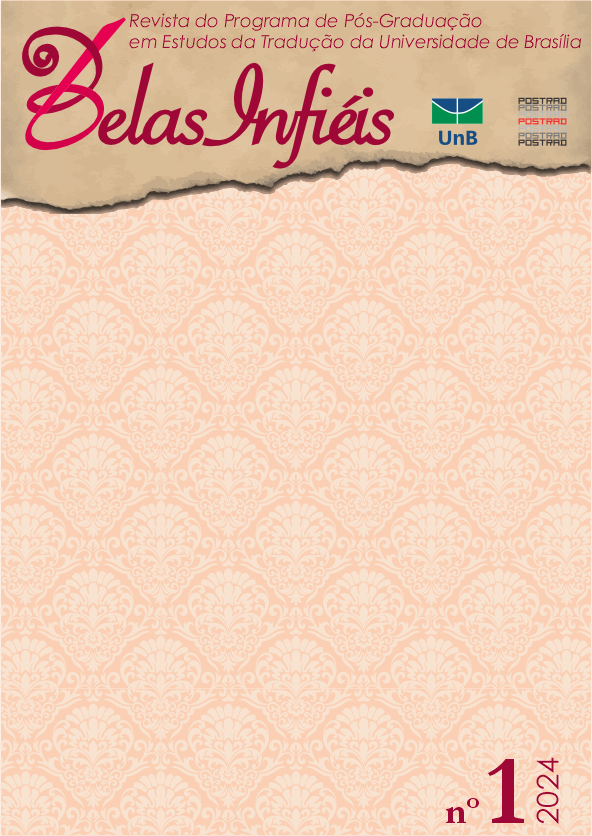A critical analysis of manuals for interpreters in refugee contexts
DOI:
https://doi.org/10.26512/belasinfieis.v13.n1.2024.51483Keywords:
Community interpreting. Language assistance. Refuge. Corpus-assisted discourse analysis. Interpreter education.Abstract
The intensification of human mobility makes it necessary to reflect on how to ensure the linguistic rights of people with little or no proficiency in the official language(s) of a country, including refugees, who are excluded from assistance systems because they speak different languages from the agents who provide these services. Faced with such a challenge, it is necessary to implement a language assistance policy, based on the creation of an integrated training, certification and accreditation system for language mediation professionals. Although few countries offer specialized courses in the field, many of them rely on manuals and codes of ethics to guide the work of community interpreters, which are drawn up without the necessary basis in linguistic studies or, even less so, in specialized reflections on translation/interpretation. In this context, this reflection aims to describe some of these materials, focusing on the concepts of language, translation and interpreting and the representations that emerge from them. The data was processed using corpus-driven discourse analysis, which allowed us to identify the predominance of an idealized and fanciful view of the translation activity and the role of the community interpreter, manifested linguistically through words such as “neutrality”, “impartiality” and “precision”, among many others. It can be seen that, although produced by countries with a history of welcoming immigrants and with language assistance services, the manuals convey reductionist and essentialist concepts of the supposed transparency and invisibility of the translation activity.
Downloads
References
REFERÊNCIAS
Bancroft, M. A. (2015). Community interpreting: A profession rooted in social justice. In H. Mikkelson, & R. Jourdenais, The Routledge Handbook of Interpreting (pp. 217-235). New York: Routledge.
Barsky, R. F. (1996). The Interpreter as Intercultural Agent in Convention Refugee Hearings. The Translator, pp. 45-63.
Creeze, I. H., & Hayward, M. (2013). Issues for interpreters and. Journal of Applied Linguistics and practice, 8(3), pp. 253-273. https://doi.org/10.1558/japl.v8i3.253
Davidson, B. (2000). The interpreter as institutional gatekeeper: The social‐linguistic role of interpreters in Spanish‐English medical discourse. Journal of Sociolinguistics, 4(3), pp. 379-405. https://doi.org/10.1111/1467-9481.00121
Declaração Universal dos Direitos Linguísticos. (1996). UNESCO. Recuperado de http://www.dhnet.org.br/direitos/deconu/a_pdf/dec_universal_direitos_linguisticos.pdf
Garcia, F. de D., & Gorovitz, S. (2020). O intérprete comunitário: sua agência na entrevista de solicitação de refúgio. Tradterm, 36, 72–101. https://doi.org/10.11606/issn.2317-9511.v36i0p72-101
Mason, I. (2014). Triadic exchanges: Studies in dialogue interpreting. New York, NY: Routledge.
Pöllabauer, S. (2013). Community interpreting. In Chapelle, C. (Ed.), The encyclopedia of applied linguistics (pp. 1–7). Oxford:Wiley-Blackwell
Pöllabauer, S. (2004). Interpreting in asylum hearings. International Journal of Research and Practice in Interpreting, 6(2), 143–180. https://doi.org/10.1075/intp.6.2.03pol
Reddy, M. J. (1993). The conduit metaphor: A case of frame conflict in our language about language. In A. Ortony (Ed.), Metaphor and thought (pp. 164–201).
Rudvin, M. (2005). Power behind discourse and power in discourse in community interpreting: The effect of institutional power asymmetry on interpreter strategies. Revista Canaria de Estudios Ingleses, 51, 159–179. https://riull.ull.es/xmlui/bitstream/handle/915/18851/RCEI_51_%28%202005%29_10.pdf?sequence=1&isAllowed=ySilva, G. J., Cavalcanti, L., Oliveira, T., Costa, L. F. L., & Macedo, M. (2021). Refúgio em Números (6ª ed.). Observatório das Migrações Internacionais; Ministério da Justiça e Segurança Pública/Comitê Nacional para os Refugiados. Brasília, DF: OBMigra. https://portaldeimigracao.mj.gov.br/images/dados/relatorios_conjunturais/2020/Ref%C3%BAgio_em_N%C3%BAmeros_6%C2%AA_edi%C3%A7%C3%A3o.pdf
Silva, G. J., Cavalcanti, L., Oliveira, T., & Macedo, M. (2020). Refúgio em Números (5ª ed.). Observatório das Migrações Internacionais; Ministério da Justiça e Segurança Pública/Comitê Nacional para os Refugiados. Brasília, DF: OBMigra. https://portaldeimigracao.mj.gov.br/images/dados/Ref%C3%BAgio%20em%20n%C3%BAmeros/REF%C3%9AGIO_EM_N%C3%9AMEROS_5%C2%AA_EDI%C3%87%C3%83O.pdf
Tipton, R., & Furmanek, O. (2016). Dialogue interpreting: A guide to interpreting in public services and the community. New York, NY: Routledge.
Valverde da Silva, J. C. (2023). Uma análise crítica de manuais de atuação de intérpretes em contexto de refúgio como base para uma reflexão sobre a formação em interpretação comunitária (Dissertação de Mestrado, Universidade de Brasília).
Wadensjö, C. (1998). Interpreting as interaction. London & New York, NY: Routledge.
Downloads
Published
How to Cite
Issue
Section
License
Copyright (c) 2024 CC BY

This work is licensed under a Creative Commons Attribution 4.0 International License.
Given the public access to this journal, the texts are free to use but requires the recognition of the original authorship and initial publication in this journal to be properly stated.
 The journal allows the use of works published for non-commercial purposes, including the right to submit the work to publicly accessible databases. Published contributions are the sole and exclusive responsibility of the author(s).Â



















